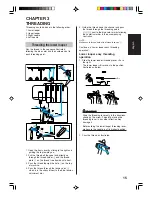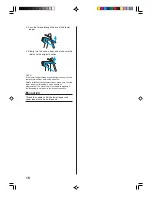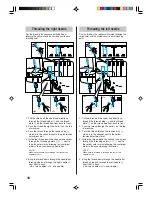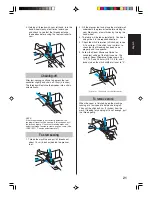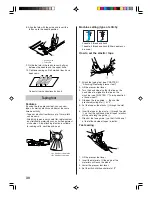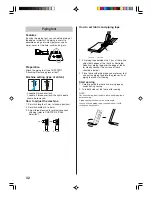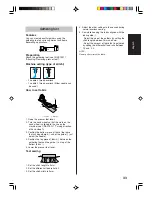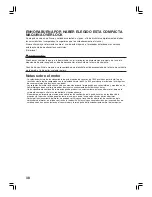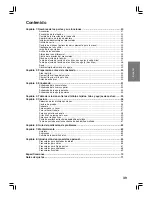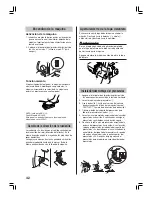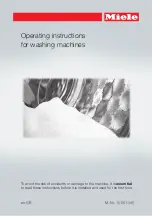
29
English
Procedure
1. Attach the blind stitch foot (see CHAPTER 1
"Attaching/ Removing presser foot").
2. Set up the machine for 3 thread overlock with
one needle in the left position.
The right needle should be removed.
3. Fold the fabric as shown in the illustration.
1
Surface
4. Turn the hand wheel so that the line on the
hand wheel is aligned to the line on the
machine (see CHAPTER 1 "Turning direction
of hand wheel").
5. Lift the presser foot lever and insert the fabric
with the folded edge in such a way that the
needle pierces just on the fold.
6. Lower the presser foot lever, adjust the fabric
guide toward the folded edge.
7. Adjust the guide position of the presser foot
with the adjusting screw so that the needle
moves down to a position 1/8 inch (2.5 to 3.0
mm) inside the folded edge of the fabric, so
that some of the stitching loops over the edge.
!
2
Adjusting screw
3
Fabric guide
By turning the screw forward the fabric guide
will go to the right. By turning the screw
backward the fabric guide will go to the left.
To adjust the position of the fabric guide, a
piece of the same fabric can be used to do a
sewing test.
8. While holding the fabric pieces together, sew
at a constant speed down the fold.
9. When stiching is finished, pull the fabric open
(flat).
Either stitch finish can be used on the right
side of the fabric. If you sew with the wrong
sides together, the upper looper thread will
decorate the right side when pulled flat. If you
sew with the right sides together, the needle
thread ladder will decorate the right side when
pulled flat.
NOTE:
This method is not suitable for thin fabrics.
Pin tuck stitching
The Pin tuck stitch uses a rolled edge to add
shape and decoration to any sewing project.
Contrasting thread in the upper looper adds an
accent to your project.
For thin fabrics, it's a good idea to choose a fine
thread which will run smoothly.
Procedure
1. Attach the blind stitch foot (see CHAPTER 1
"Attaching/ Removing presser foot").
2. Set up the machine for narrow overlock
stitching. (Refer to CHAPTER 5 "Narrow
overlock/ Rolled hemming stitch".)
3. Draw equally spaced lines on the fabric with a
fabric pencil as guides for pin tuck placement.
Fold the fabric along one of the lines and
press in place lightly with an iron.
1
Making lines
2
Fold in two
4. Turn the hand wheel so that the line on the
hand wheel is aligned to the line on the
machine (see CHAPTER 1 "Turning direction
of hand wheel").
5. Lift the presser foot lever and insert the fabric
with the folded edge in such a way that the
needle pierces just the folded edge.
6. Lower the presser foot lever, adjust the fabric
guide toward the folded edge.
7. Align the blind stitch presser foot guide with the
line on the right side of the stitch finger.
By turning the screw forward the stitch guide
will go to the right. By turning the screw
backward the stitch guide will go to the left.

